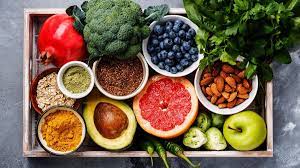
The term ‘superfood’ was introduced in the 1990s to indicate a particular food category with superior nutritional properties. There are many definitions of ‘superfood’, but it usually includes foodstuffs characterized by their richness in macro- and micronutrients, which have positive effects on human health and are helpful for illness prevention. These nutrient-rich powerhouses contain vitamins, minerals, antioxidants, and other health-boosting compounds that can positively impact your overall health. Some of the superfoods are:
Amla, also known as Indian gooseberry, is often considered a superfood due to its impressive nutritional profile and numerous potential health benefits. It has an essential role in the traditional medicine of India to reduce anxiety and burning sensation in the skin and eyes, improve the anemic condition, favor the health of the male reproductive system and reproduction, facilitate digestion, improve liver health, and also exert a tonic effect in the cardiovascular system.
Kale commonly known as Karam Saag contains a variety of micronutrients, including vitamins and minerals, antioxidants, carotenoids, glucosinolates, and polyphenols, which are beneficial to human health. Kale is also a good source of prebiotic carbohydrates and phytochemicals, such as folic acid, riboflavin, carotenes, and others that serve as antioxidants, capturing free radicals and aiding in reducing inflammation. Owing to these properties, kale has become widely known as a medicinal food source to treat bowel ailments, obesity, malnutrition problems, and chronic diseases, such as cardiovascular disease and cancer.
Millets, in contrast to rice and wheat, are not only a good source of energy and major nutrients, including protein but are also a good source of micronutrients such as vitamins, including vitamins A, B, D, E, niacin, pyridoxine, antioxidants, iron and zinc. Millets contain many protective polyphenols such as hydroxycinnamic acid, catechin, quercetin, luteolin, orientin, apigenin and isoorientin. These polyphenols have an antioxidant activity with free radical scavenging action and anti-inflammatory activity. Millets have anti-diabetic, anti-obesity and anti-hypertensive properties.
Berries are often classified as superfoods due to their nutritional content and potential health benefits. Berries, including blueberries, strawberries, raspberries, and blackberries, are packed with antioxidants such as anthocyanins, quercetin, and vitamin C. These antioxidants help protect the body from oxidative stress, which is linked to various chronic diseases and aging.
While superfoods can be a valuable addition to your diet, they are most effective when part of a well-balanced eating plan. Variety ensures you receive a wide range of nutrients and health benefits. So, start taking these superfoods in your diet to eat healthier.















